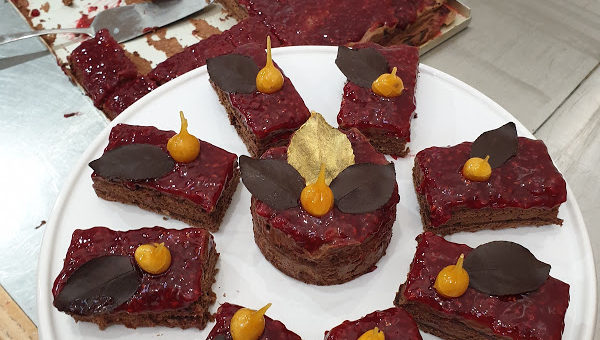Have your cake and eat it too
I thought there was no better way to start the #ThatTranslatorCanCook challenge and my patisserie journey than to try an ‘intermediate’ recipe by renowned French pastry chef Christophe Felder. You basically make a large rectangular cake made up of different layers and cut it up into individual portions. It boasts a layer of chocolate joconde sponge, brushed with raspberry syrup, a layer of melted chocolate, followed by chocolate mousse, another layer of joconde, syrup, chocolate and mousse, all finally topped off with a raspberry glaze. That’s technically nine layers in total! I decided to decorate mine with caramelised hazelnuts and handmade chocolate leaves, which I’ll cover in a later post on decoration.
At first glance it sounds very rich and chocolatey, but it’s actually fairly light and well-balanced. The melted chocolate solidifies to provide a very satisfying crunchy texture in the middle, and the dark chocolate pairs wonderfully with the tart raspberry compote glaze. I questioned whether the raspberry syrup in the middle layers was absolutely necessary, but after performing a taste test without the compote, I can confirm that the flavour really does come through beautifully and carries the raspberry all the way down to the base.
I’ve actually made this cake no fewer than four (4!) times, all within the space of three weeks, and have since vowed to steer clear of baking with chocolate for a long time. The first was for my husband’s birthday, and the subsequent occasions were practising for the Great British Bake Off application process, but that’s another story. Mr Felder’s recipes are designed for the many, not for the few, and after making the full quantity the first time (serves 20), I decided to opt for half the amount the last three times, for a much more sensible quantity of leftover cake.
I’m not going to lie, it was a sad time when I finally stopped baking it and for the first time in three weeks there was no cake left in the house. One can quickly grow accustomed to a daily portion of a nine layer entremet.
Translation
What’s in a name?
The simple French ‘Chocolat-Framboise’ leaves a lot to the imagination and an English audience wouldn’t know much about what kind of cake this was, so my first challenge was to choose an appropriate name. I’ve seen this cake translated elsewhere as a “glazed raspberry chocolate cake” which doesn’t account for the layers. I decided to opt for ‘chocolate and raspberry layer cake’ to recognise the various different carefully layered elements this cake involves (sponge, chocolate, raspberry compote and mousse).

Being eggstra precise
I’ve come to realise that French recipes have a habit of weighing out egg whites and yolks for some cake components. In this recipe the precise amount of egg whites and yolks have been specified for the joconde sponge, but interestingly, not for the chocolate mousse. Presumably mousse is more forgiving than sponge? In English recipes I have only ever seen egg whites specified in grams for macarons, or other types of meringue, where precision is absolutely vital. Baking is a science and it seems sensible to be as precise as possible for the less forgiving elements, and any leftover egg can always be used as egg wash to glaze other baked goods, such as a pie or bread.
On the subject of eggs, the recipe instructs the baker to “battre les œufs”. “Battre” can mean both beat and whisk, so it’s important here to know what the recipe requires. As this was in the instructions for making mousse, I knew the eggs would need whisking. This isn’t a mistake you want to make; you don’t want a mousse with no air in it!
For the joconde, the recipe asks you to “fouetter les blancs en neige”, literally: whisk the whites into snow. I enjoy the imagery this provides for whisking egg whites, but it can be somewhat vague, as it does not specify to which stage they need to be whisked. Should they be soft peaks or stiff peaks? It could mean both, depending on the context. It’s important to be able to distinguish between the two as the answer will affect the final product. In this context I know it means soft peaks, as it is for a joconde sponge and the sugar will be added later, at which stage the mixture will then need whisking to stiff peaks. This differentiation is key for the recipe to be successful.
In hot water
The chocolate layers in this cake are melted over a ‘bain marie’. Although this term is slowly creeping into the English language, the unseasoned baker may not understand the term, so I decided to explain that it means putting the chocolate in a bowl set over a barely simmering pan of boiling water, which is a description commonly used in English recipes.
Overall this was a really enjoyable cake to translate, bake and eat. I would highly recommend it for something special. While I can’t include the recipe here for copyright reasons, you can find the same recipe with a twist here.
Until next time…



